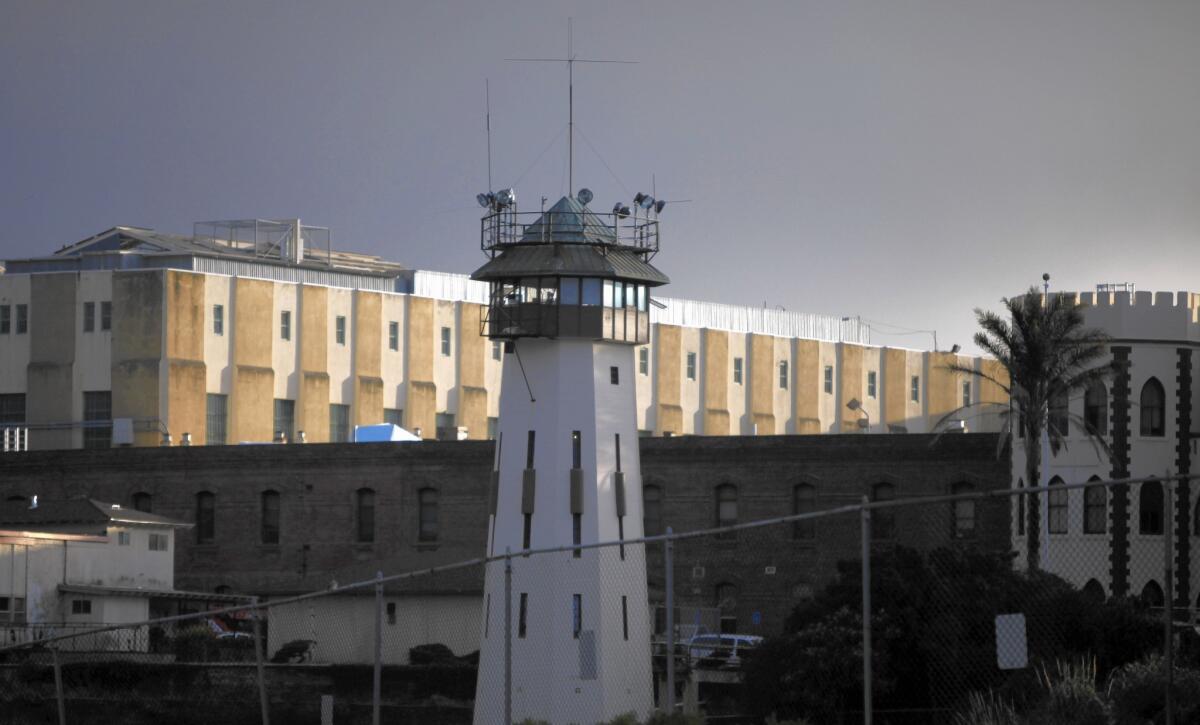California’s death row, with no executions in sight, runs out of room

- Share via
With no executions in nearly a decade and newly condemned men arriving each month, the nation’s largest death row has run out of room.
Warning that there is little time to lose, Gov. Jerry Brown is asking the California Legislature for $3.2 million to open nearly 100 more cells for condemned men at San Quentin State Prison. The proposed expansion would take advantage of cells made available as the state releases low-level drug offenders and thieves under a new law voters approved last year.
California’s death penalty has been the subject of a decade of litigation. One case led to a halt to executions in 2006. Another resulted in a federal judge’s ruling last July that the state’s interminably slow capital appeals system is unconstitutionally cruel. Through it all, the death row population has grown from 646 in 2006 to 751 today.
“Until the litigation is resolved, this cost-effective proposal allows [the state corrections department] to safely house condemned inmates going forward,” corrections department spokeswoman Terry Thornton said last week.
Legislators would have to approve the governor’s funding request as part of the state’s $113-billion budget.
But critics of Brown’s handling of the state’s stalled death penalty say his proposal doesn’t address deeper problems with the California system. “This is a failure of Gov. Brown to do the things within his power to move things forward,” said Kent Scheidegger, legal director of the Criminal Justice Legal Foundation, a group that has sued California seeking to force the state to resume executions.
There are 731 men and 20 women on California’s death row. The women are housed in a maximum security unit at the Central California Women’s Facility near Chowchilla, and Brown’s proposal would not affect them.
Condemned men live at San Quentin, housed apart from other inmates in three cellblocks that Brown’s budget plans note would have overflowed already if the state last summer had not, under court order, opened a 25-cell psychiatric unit for death row inmates.
San Quentin’s death row can accommodate 715 inmates. Last week, prison officials said, 708 inmates were in those cells. Twenty-three others were scattered across the state for court hearings or held in long-term medical facilities or at prisons in other states.
The governor’s budget proposal anticipates an average of 20 new arrivals on death row yearly. He proposes putting them in 97 cells on the first two tiers of the five-tier South Block. A small portion of the funding would go to beef up security, including modifying showers so condemned inmates can be shackled as they bathe. The majority of the money would be spent to increase staff, and the expansion would begin in July.
“Based on the critical nature of the bed shortage, it is not feasible to delay the approval and implementation of this proposal,” the governor’s budget document states. If expansion is delayed, “San Quentin would not have beds to accommodate the condemned should any return from court, outside medical facilities, or if SQ receives any newly condemned inmates.”
The proposed expansion of death row is possible because California’s prison population outside of death row has fallen sharply, a result of court-ordered releases to reduce overcrowding and a measure approved by voters last fall allowing the release of some low-level felons. Meanwhile, without executions, the ranks of California’s condemned continue to swell.
State and federal courts since 2006 have barred the state from using its three-drug lethal-injection protocol. Brown in 2012 asked an advisory board to investigate a single-drug method, but none has been proposed, and the state lacks a court-approved method for executions.
The constitutionality of the state’s capital punishment system is also being challenged. A federal judge last July ruled that the appeals process is so slow that executions have become unlikely and random. Condemned inmates often wait years for lawyers to be appointed to their appeals and years more for the state Supreme Court to decide their cases. Atty. Gen. Kamala Harris is challenging the ruling in the 9th Circuit Court of Appeals. She argues that the lengthiness of the appeals process prevents capital punishment from being arbitrary.
Forty-nine inmates have died of cancer, drug overdose, suicide or other causes since the last execution, including two this month. Teofilo Medina Jr., 70, who murdered three store clerks for petty cash during a robbery spree in 1984, died of cancer March 22. Leon Cooper, 54, convicted of the 1998 rape and murder of his stepdaughter, died March 18 at a Marin County hospital. Officials have not said what caused his death.
Brown’s proposal is scheduled for a hearing in late April before a budget subcommittee led by Sen. Loni Hancock (D-Berkeley), a vocal opponent of the death penalty. This month, she and other lawmakers told a federal court that the state cannot adequately fund its capital punishment system and should abandon the effort.
But because the process continues, Hancock said in a written statement to The Times, the Legislature must pay for more death row cells.
“California is in a Catch-22 situation. We are required by the Courts to address prison overcrowding and we are required by law to provide certain minimum conditions for housing death penalty inmates,” Hancock wrote. “The Legislature can’t avoid its responsibilities in these areas, even though the courts are currently considering the constitutionality of the death penalty, and I hope will agree to end it.”
ALSO:
Q&A: Why Utah wants to revive execution by firing squad
Felons turn to ‘pardon guy’ to verify that they’re rehabilitated
Nevada barber lives by lessons from former clients on Georgia’s death row
More to Read
Sign up for Essential California
The most important California stories and recommendations in your inbox every morning.
You may occasionally receive promotional content from the Los Angeles Times.











